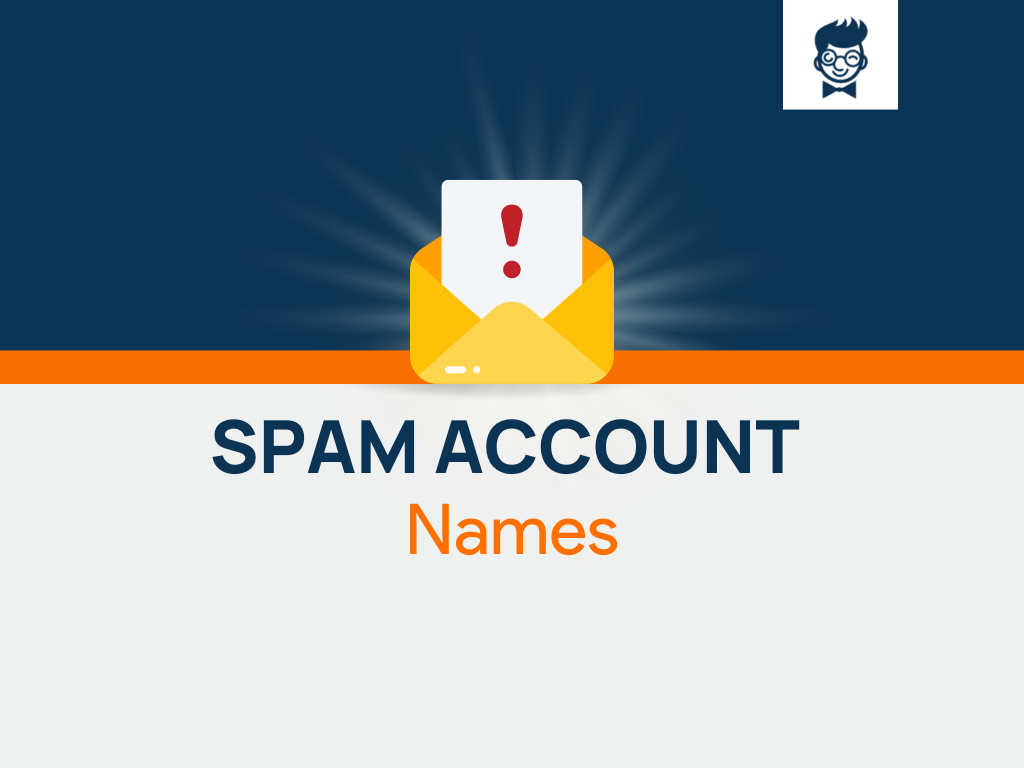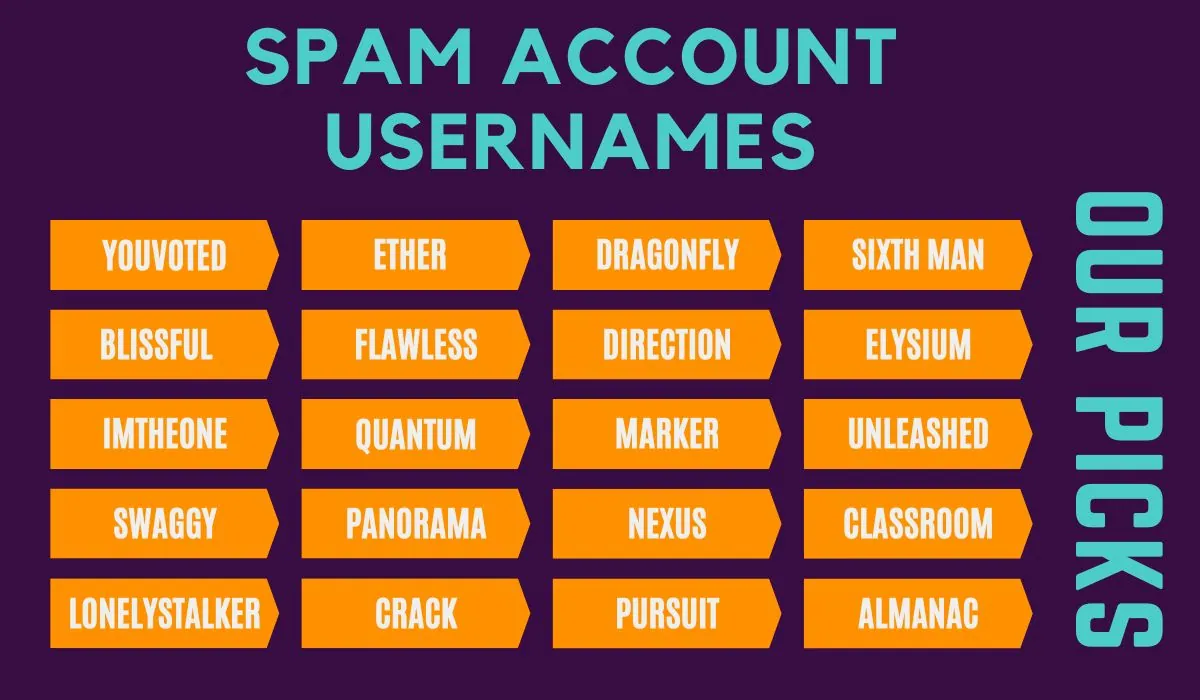Spam usernames are everywhere, and they're not just annoying—they can pose serious security risks. If you've ever signed up for an online platform, chances are you've encountered a username like "DiscountV1agra" or "FreeCryptoMining." These spammy usernames aren't just there to clutter your feed; they're designed to trick you into clicking links or giving away sensitive information. In this guide, we’ll explore what spam usernames are, why they exist, and how you can protect yourself from their sneaky tactics.
Whether you're a casual internet user or a tech-savvy professional, understanding the ins and outs of spam usernames is crucial in today's digital world. From social media platforms to online forums, these usernames can infiltrate any space where users interact. But don't worry—we've got your back. This article will break down everything you need to know about spam usernames, including how to identify them and how to stop them from ruining your online experience.
So, buckle up and get ready to dive deep into the world of spam usernames. By the end of this guide, you'll be armed with the knowledge and tools to keep your online presence safe and spam-free. Let's get started!
Table of Contents:
- What Are Spam Usernames?
- Why Do Spam Usernames Exist?
- Common Traits of Spam Usernames
- How to Identify Spam Usernames
- Risks Associated with Spam Usernames
- Preventing Spam Usernames
- Tools to Fight Spam Usernames
- Best Practices for Online Safety
- Real-World Examples of Spam Usernames
- Conclusion and Next Steps
What Are Spam Usernames?
Let's start with the basics. Spam usernames are fake or misleading usernames created by bots or individuals with malicious intent. These usernames often appear on social media platforms, forums, comment sections, and even dating apps. Their primary goal is to promote products, services, or scams, or to spread malware and phishing links.
For example, imagine you're scrolling through your favorite online community when you come across a username like "GetRichQuickNow123." At first glance, it might seem harmless, but if you click on their profile, you'll likely find links to dubious investment schemes or fake offers. Spam usernames are designed to catch your attention and trick you into taking actions that could compromise your security.
Why Spam Usernames Are a Problem
Spam usernames aren't just annoying; they can have serious consequences. They can lead to identity theft, financial loss, and even reputational damage. For businesses, spam usernames can harm brand credibility and drive away legitimate users. That's why it's essential to understand how to spot and handle them effectively.
Why Do Spam Usernames Exist?
Spam usernames exist because they work. Cybercriminals and marketers use these usernames to exploit unsuspecting users. By creating accounts with catchy or misleading names, they can lure people into clicking malicious links, downloading harmful software, or providing personal information.
Here’s a quick breakdown of why spam usernames are so effective:
- They prey on human curiosity. A username like "FreeiPhoneGiver" is bound to grab attention.
- They exploit trust. Many users assume that usernames on reputable platforms are legitimate.
- They scale quickly. Bots can generate thousands of spam usernames in seconds, making them hard to control.
It's a cat-and-mouse game between platform administrators and spammers, and unfortunately, the spammers often win—unless users take proactive steps to protect themselves.
Common Traits of Spam Usernames
Spam usernames may vary in appearance, but they often share certain characteristics. By learning to recognize these traits, you can spot spam usernames more easily. Here are some common features:
1. Keywords and Promotional Language
Spam usernames frequently include keywords related to money, health, or technology. Examples include "CryptoGains," "WeightLossSecrets," or "BestDealsOnline." These keywords are chosen because they appeal to common desires or needs.
2. Numbers and Symbols
Spammers often use numbers and symbols to make their usernames harder to detect. For instance, instead of writing "FreeMoney," they might use "Fr33M0n3y." This tactic is called "leetspeak," and it's a favorite among spammers trying to evade filters.
3. Overly Long or Short Names
Another red flag is usernames that are either excessively long or extremely short. A username like "DiscountV1agra12345" or simply "FreeStuff" is likely to be spam. These names are designed to stand out without providing any meaningful information.
How to Identify Spam Usernames
Identifying spam usernames requires a combination of critical thinking and vigilance. Here are some practical tips to help you spot them:
Look for Suspicious Patterns: Pay attention to usernames that seem out of place or overly promotional. If a username promises something too good to be true, it probably is.
Check the Profile: Most spam accounts have incomplete or generic profiles. If a username claims to offer "free iPhones," but their profile picture is a default avatar, that's a major warning sign.
Inspect the Activity: Spam accounts often post repetitive or irrelevant content. If a username has hundreds of posts promoting the same product, it's likely a bot.
Red Flags to Watch For
- Usernames with random combinations of letters and numbers.
- Profiles with no followers or following.
- Posts filled with links to external websites.
By staying alert and using these strategies, you can minimize the chances of falling victim to spam usernames.
Risks Associated with Spam Usernames
Spam usernames aren't just annoying—they can cause real harm. Here are some of the risks associated with interacting with spam accounts:
1. Phishing Attacks
Phishing is one of the most common tactics used by spammers. They create usernames that mimic legitimate brands or individuals, tricking users into sharing sensitive information like passwords or credit card details.
2. Malware Distribution
Some spam usernames link to websites that download malicious software onto your device. This software can steal your data, encrypt your files, or even take control of your system.
3. Financial Scams
Many spam usernames promote get-rich-quick schemes, fake investments, or counterfeit products. Falling for these scams can lead to significant financial losses.
It's crucial to remember that spam usernames aren't just harmless pranks—they're potential threats to your online security.
Preventing Spam Usernames
Preventing spam usernames requires a combination of individual effort and platform intervention. Here are some steps you can take to protect yourself:
1. Enable Two-Factor Authentication (2FA)
Two-factor authentication adds an extra layer of security to your accounts, making it harder for spammers to gain access. Most major platforms offer 2FA as an option, so be sure to enable it wherever possible.
2. Use Strong Passwords
A strong password is your first line of defense against spam accounts. Avoid using simple or predictable passwords, and consider using a password manager to generate and store complex passwords.
3. Report Suspicious Accounts
Most platforms have mechanisms for reporting spam accounts. If you come across a suspicious username, take a moment to report it. This helps protect other users and keeps the platform cleaner.
By taking these proactive steps, you can significantly reduce the impact of spam usernames on your online experience.
Tools to Fight Spam Usernames
Thankfully, there are several tools and technologies designed to combat spam usernames. Here are a few worth considering:
1. Anti-Spam Plugins
Many platforms offer anti-spam plugins that automatically detect and block spam accounts. These plugins use advanced algorithms to analyze usernames and behaviors, flagging potential threats before they cause harm.
2. CAPTCHA Systems
CAPTCHA systems are designed to distinguish between human users and bots. By requiring users to solve puzzles or identify images, CAPTCHA helps prevent spammers from creating fake accounts en masse.
3. AI-Powered Filters
Some platforms use AI-powered filters to detect and remove spam usernames in real-time. These filters analyze patterns and behaviors, learning over time to become more effective at identifying spam.
While no tool is foolproof, combining these methods can greatly enhance your protection against spam usernames.
Best Practices for Online Safety
In addition to specific strategies for dealing with spam usernames, there are general best practices for staying safe online. Here are a few tips:
1. Stay Skeptical
Always question the legitimacy of usernames, especially if they seem too good to be true. Trust your instincts—if something feels off, it probably is.
2. Keep Software Up-to-Date
Regularly updating your software ensures that you have the latest security patches and features. Outdated software can leave you vulnerable to attacks.
3. Educate Yourself
The more you know about online threats, the better equipped you'll be to handle them. Stay informed about the latest trends in cybercrime and adjust your practices accordingly.
By following these best practices, you can create a safer and more secure online environment for yourself and others.
Real-World Examples of Spam Usernames
To illustrate the impact of spam usernames, let's look at a few real-world examples:
Example 1: Social Media Scams
In 2020, a wave of spam usernames appeared on Twitter, promising free gift cards to followers. These accounts used names like "AmazonRewards2020" and "FreeGiftCardNow," tricking thousands of users into clicking malicious links.
Example 2: Forum Spam
On a popular tech forum, a username called "TechSupportHelper" posted links to fake antivirus software. Many users downloaded the software, only to discover that it was actually malware designed to steal their data.
These examples highlight the importance of vigilance and education when it comes to spam usernames.
Conclusion and Next Steps
Spam usernames are a persistent problem in the digital world, but they don't have to ruin your online experience. By understanding their characteristics, risks, and prevention methods, you can take control of your online presence and protect yourself from potential threats.
Here’s a quick recap of what we’ve covered:
- Spam usernames are fake or misleading usernames created with malicious intent.
- They pose risks such as phishing attacks, malware distribution, and financial scams.
- You can prevent spam usernames by using strong passwords, enabling 2FA, and reporting suspicious accounts.
- Tools like anti-spam plugins and CAPTCHA systems can help combat spam usernames.
- Stay safe online by staying skeptical, keeping software up-to-date, and educating yourself about cyber threats.
Now it's your turn to take action. Whether it's reporting spam accounts, enabling 2FA, or simply being more vigilant online, every step you take contributes to a safer digital world. Share this article with your friends and family to help spread awareness, and don't hesitate to leave a comment below if you have any questions or insights to share. Together, we can fight spam usernames and create a better online experience for everyone!


